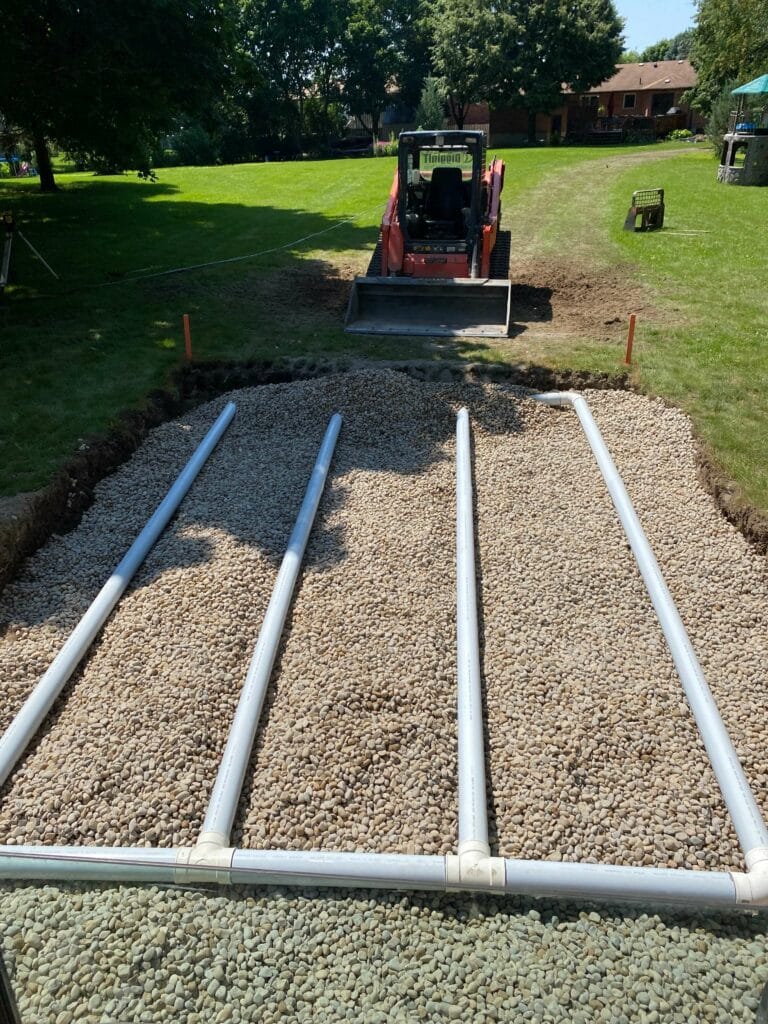
Designing a septic system is a critical process that affects the efficiency, sustainability, and lifespan of a home’s wastewater treatment capacity. In this blog post, we’re going to dive into septic system design and discuss why it matters, and the important factors to consider when working with professionals when planning and installing a septic system. We’ll also highlight how Steeltooth Contracting, particularly in the Barrie region, brings value to this process through our expertise and experience.
The Basics of a Septic Systems
A septic system is an on-site sewage treatment structure usually installed in rural areas where public sewer systems do not exist. The system creates a small-scale sewage treatment process that allows the waste to decompose through natural processes. The key components typically include a septic tank, a drain field, and sometimes a pump tank.
Understanding these components is essential to designing a septic system. The tank, typically made from concrete, holds the wastewater from your house until solids settle at the bottom (sludge) and lighter materials float to the top (scum). The drain field is an underground area of your property where effluent from the septic tank flows for final treatment and absorption by the soil.
The Importance of Septic Systems
Designing a septic system is not a one-size-fits-all process. It requires a good understanding of the local environment, code regulations, and the specific needs of the property. An efficient design not only enhances the lifespan of your septic system but also protects the environment by ensuring proper waste disposal. Additionally, a well-designed system saves homeowners the time, hassle, and cost of maintenance issues and possible health concerns associated with failing systems.
Factors to Consider in Your Septic System
When designing a septic system, a number of variables need to be considered:
Soil Type and Characteristics
The type and characteristics of your soil play a crucial role in the design. The soil’s percolation rate (how fast it absorbs water) determines the size of the drain field. For example, sandy soil allows water to flow through it faster than clay soil, meaning a smaller drain field can be used.
Size and Layout of Your Property
Your property’s size and topography will determine the septic system’s location. For instance, a house on a large, flat plot will have more options for the placement of the system compared to a small, sloping property.
Household Size and Wastewater Generation
The number of people living in the house and the average daily water use will determine the size of the septic tank required. For example, a large family would likely need a larger tank than a single individual.
Local Regulations and Requirements
Local health department and environmental regulations vary by location and must be adhered to in the design and installation process. In Ontario, for instance, specific guidelines and permits are required for septic system installation.
Common Septic System Options
There are various approaches available to planning a septic systems, each suited to different soil types, groundwater levels, and property layouts. Conventional systems are the most common, consisting of a septic tank and a gravel-based drain field. Low-pressure dosing systems are used when the soil is not suitable for a conventional system. Mound systems are an alternative for properties with shallow soil or high groundwater.
Aerobic treatment units add an aeration process that increases the decomposition rate of the waste. These are often used for small properties or in locations with environmental restrictions.
Septic System Innovations
Septic systems and their design are constantly evolving, with new innovations making systems more efficient, eco-friendly, and suitable for a wider range of conditions. For example, systems can now be designed to reuse treated wastewater for subsurface landscape irrigation, saving water in dry climates.
At Steeltooth Contracting, we stay on top of these trends to ensure that we can provide the most advanced, efficient, and environmentally friendly systems for our clients.
The Role of Steeltooth Contracting in Septic System Design
With years of experience in designing and installing septic systems, Steeltooth Contracting has helped countless homeowners in Ontario design and install septic systems tailored to their specific needs. Our team of professionals carefully considers all the factors and requirements for each project, providing systems that function optimally while respecting the environment.
Conclusion: Why Your System Design Matters
Septic design is more than just digging a hole and installing a tank. It’s about understanding the intricacies of wastewater treatment, considering the environment, and adhering to local codes and regulations. It’s about creating a system that works efficiently for many years, protecting the health of both the homeowner and the environment.
At Steeltooth Contracting, we take this responsibility seriously. We know that our clients in Barrie and beyond depend on us to design systems that meet their needs, and we are proud to deliver every time.
If you’re considering installing a septic system, or need to replace an existing one, contact us today. We’re here to help ensure your system is designed and installed correctly from the start. Don’t leave the planning and process of your septic system to chance. Reach out to Steeltooh Contracting, where we make the complex simple.


